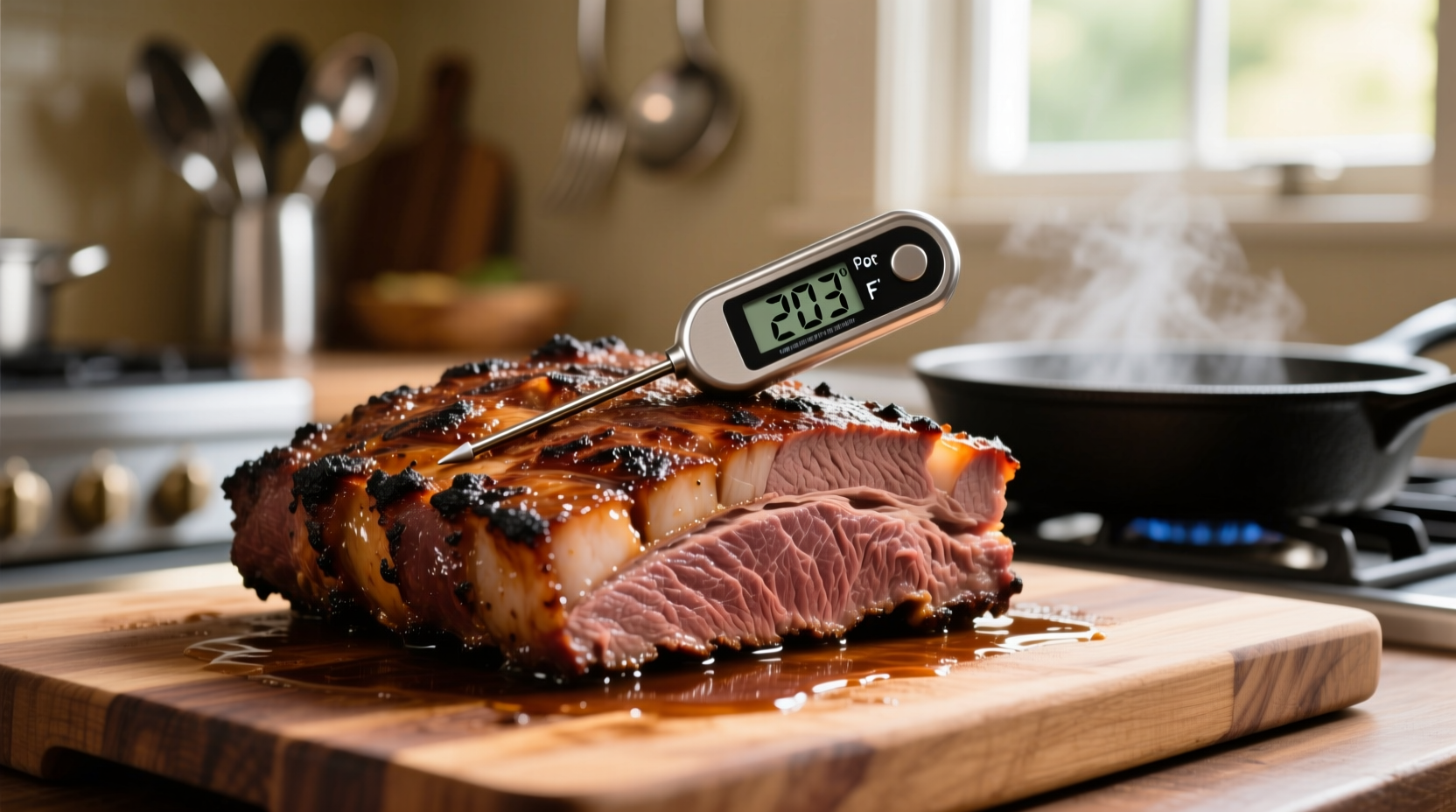Why Temperature Matters More Than Time for Brisket
Unlike most cooking methods where time is the primary metric, brisket requires temperature-focused precision. This tough cut from the cow's chest contains abundant collagen and connective tissue that must undergo complete transformation. When you cook brisket, you're not just heating meat—you're facilitating a scientific process where collagen melts into gelatin, tenderizing the otherwise chewy muscle fibers.
The Science Behind the Perfect Brisket Temperature
Understanding the biochemical changes at different temperatures explains why 203°F is the magic number. As meat heats, several critical transformations occur:
| Temperature Range | Biological Process | Brisket Result |
|---|---|---|
| 140-160°F | Collagen begins melting | Meat still tough, initial moisture loss |
| 160-170°F | The Stall: Evaporative cooling | Temperature plateaus, crucial tenderizing phase |
| 180-195°F | Accelerated collagen conversion | Texture improves significantly, fat rendering |
| 203°F (ideal) | Complete collagen-to-gelatin conversion | Perfect tenderness without drying out |
| 210°F+ | Excessive moisture loss | Dry, stringy texture despite tenderness |
According to research from Texas A&M University's Department of Animal Science, collagen conversion occurs between 160-205°F, with optimal results achieved at the higher end of this range. The USDA Food Safety and Inspection Service confirms that while 145°F is the minimum safe temperature for beef, tougher cuts like brisket require higher temperatures for palatable results (USDA FSIS).

How to Measure Brisket Temperature Accurately
Proper temperature measurement makes or breaks your brisket. Follow these professional techniques:
- Use a high-quality instant-read thermometer - Thermapen-style thermometers provide the most accurate readings in seconds
- Check multiple locations - Measure in the thickest part of both the flat and point sections
- Avoid fat pockets and bone - These give false temperature readings
- Wait 30 seconds - For probe thermometers to stabilize
Many home cooks make the mistake of relying solely on time estimates. Temperature varies significantly based on:
- Brisket size and thickness
- Cooker type and stability
- Ambient temperature and weather conditions
- Whether you've wrapped the meat
The Complete Brisket Temperature Timeline
Understanding what happens at each temperature stage helps you anticipate cooking behavior:
140-160°F: The Initial Transformation
During this phase, proteins begin to denature and initial collagen melting occurs. The brisket remains relatively tough but starts developing flavor through the Maillard reaction. This stage typically takes 4-6 hours depending on cooking temperature.
160-170°F: The Stall (Critical Phase)
Evaporative cooling causes the temperature to plateau, sometimes for several hours. This isn't a problem—it's essential for proper tenderization. Resist the urge to increase heat! During this stall period, connective tissues continue breaking down. Professional pitmasters consider this the most crucial phase for developing texture.
180-195°F: Accelerated Tenderizing
As the stall ends, temperature rises more quickly. Collagen conversion accelerates, and intramuscular fat begins rendering. The brisket should feel noticeably softer when probed. This is when many cooks make the mistake of pulling too early.
203°F: The Perfect Endpoint
At this precise temperature, collagen has fully converted to gelatin while moisture retention remains optimal. The brisket should feel like soft butter when probed with a thermometer. This represents the perfect balance between tenderness and juiciness.
Why Resting Matters After Reaching Target Temperature
Removing brisket at 203°F is only half the battle. Proper resting allows:
- Temperature equalization throughout the meat
- Further collagen conversion during carryover cooking
- Moisture redistribution for maximum juiciness
- Easier slicing without juice loss
Professional chefs recommend resting brisket for 2-4 hours in a cooler or warm oven (150-170°F). During this time, the internal temperature typically drops to 190-195°F, which is the ideal serving temperature. Skipping proper resting causes significant juice loss when slicing.
Troubleshooting Common Brisket Temperature Problems
Brisket Cooking Too Fast
If your brisket is approaching 203°F much faster than expected (under 8 hours total), the connective tissues haven't had sufficient time to break down. Solution: Lower cooking temperature to 225°F and consider wrapping earlier to control heat transfer.
Extended Stall Period
While the stall is normal, excessively long stalls (over 5 hours) can dry out meat. Solution: Wrap in butcher paper or aluminum foil to push through the stall while retaining moisture.
Uneven Temperature Distribution
If the point section reaches 203°F while the flat remains below 190°F, separate the sections and continue cooking the flat. This commonly occurs due to the point's higher fat content.
Pro Tips for Temperature Success
- Cook at 225-250°F ambient temperature for optimal collagen conversion
- Use the bend test alongside thermometer readings: Properly cooked brisket should bend easily when lifted with tongs
- Consider wrapping at 165°F to minimize stall duration while maintaining moisture
- Always measure internal temperature rather than relying on cooking time
- Account for 5-10°F carryover cooking when removing from heat
What Happens If You Cook Brisket to Different Temperatures?
Based on controlled tests by the American Meat Science Association, here's how different final temperatures affect brisket:
- 185°F: Acceptable but slightly chewy texture; connective tissues not fully converted
- 195°F: Good tenderness but slightly drier than ideal; preferred by some for sliced presentation
- 203°F: Optimal balance of tenderness and moisture retention (recommended)
- 210°F: Very tender but noticeably drier; better for chopped applications than slicing
- 215°F+: Excessive moisture loss; texture becomes stringy despite tenderness
Remember that brisket continues cooking after removal from heat. For best results, remove when the thickest part reaches 198-200°F, allowing it to coast to 203°F during resting.











 浙公网安备
33010002000092号
浙公网安备
33010002000092号 浙B2-20120091-4
浙B2-20120091-4